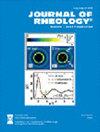Microrheological study of single chain dynamics in semidilute entangled flexible polymer solutions: Crossover from Rouse to Zimm modes
IF 3.2
2区 工程技术
Q2 MECHANICS
引用次数: 4
Abstract
The dynamics of polymer chains in entangled semidilute solution have been of theoretical and experimental interest. Among a number of characteristic lengths and times of the polymer in solution, those of the correlation blob are the key to understand the applicability of the Rouse and Zimm models to rheology of the semidilute solution. Direct rheological measurements of Rouse and Zimm modes are limited as the corresponding time scale is out of the range of classical rheological techniques. We investigated the single chain dynamics of entangled poly(ethylene oxide) in semidilute aqueous solutions by high-frequency micro-rheology based on diffusing-wave spectroscopy compared to classical shear macro-rheology. Concentration dependence of the three characteristic times of the entangled polymer chains, reptation time, entanglement time, and correlation time, was studied with the help of the time-concentration superposition. At the low frequency range, dynamic moduli measured by macro-rheology and micro-rheology showed a good agreement without adjustable parameters. At the higher frequency range, we found the Rouse regime in the mean square displacement of the probe particles and in the magnitude of the complex specific viscosity of the solution. We propose a simple method to estimate the boundary of the Rouse regime. Finally, at the high frequency range, we demonstrate that the contribution of the solvent to the solution viscosity needs to be subtracted to observe the power-law behavior of the Zimm mode.半稀释纠缠柔性聚合物溶液中单链动力学的微流变研究:Rouse模到Zimm模的交叉
聚合物链在纠缠半稀释溶液中的动力学一直具有理论和实验意义。在溶液中聚合物的许多特征长度和时间中,相关斑点的特征长度和次数是理解Rouse和Zimm模型对半稀释溶液流变学适用性的关键。Rouse和Zimm模式的直接流变测量是有限的,因为相应的时间尺度超出了经典流变技术的范围。与经典的剪切宏观流变学相比,我们采用基于散射波光谱的高频微流变学研究了纠缠聚环氧乙烷在半稀释水溶液中的单链动力学。利用时间-浓度叠加的方法研究了纠缠聚合物链的三个特征时间,即报告时间、纠缠时间和相关时间的浓度依赖性。在低频范围内,宏观流变学和微观流变学测量的动态模量在没有可调参数的情况下表现出良好的一致性。在较高的频率范围内,我们在探针颗粒的均方位移和溶液的复数比粘度的大小中发现了Rouse状态。我们提出了一种简单的方法来估计劳斯政权的边界。最后,在高频范围内,我们证明需要减去溶剂对溶液粘度的贡献,以观察Zimm模式的幂律行为。
本文章由计算机程序翻译,如有差异,请以英文原文为准。
求助全文
约1分钟内获得全文
求助全文
来源期刊

Journal of Rheology
物理-力学
CiteScore
6.60
自引率
12.10%
发文量
100
审稿时长
1 months
期刊介绍:
The Journal of Rheology, formerly the Transactions of The Society of Rheology, is published six times per year by The Society of Rheology, a member society of the American Institute of Physics, through AIP Publishing. It provides in-depth interdisciplinary coverage of theoretical and experimental issues drawn from industry and academia. The Journal of Rheology is published for professionals and students in chemistry, physics, engineering, material science, and mathematics.
 求助内容:
求助内容: 应助结果提醒方式:
应助结果提醒方式:


